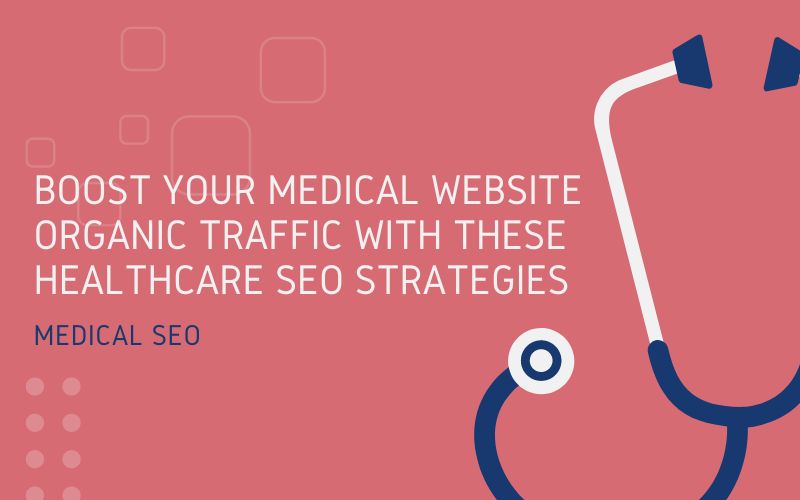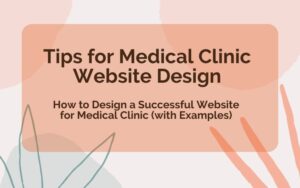Healthcare SEO plays a vital role in helping your medical website stand out in the crowded online landscape. By implementing effective SEO strategies, you can improve your visibility in search engine results, attract more potential patients, and establish your practice as a trusted authority in your field.
To boost your medical website’s performance, you’ll need to understand the basics of healthcare SEO and implement a comprehensive strategy. This includes conducting thorough keyword research, optimizing on-page elements, and following technical SEO best practices. By focusing on these key areas, you can enhance your website’s visibility, improve user experience, and ensure compliance with important regulations like HIPAA. Whether you’re running a small medical practice or managing a large hospital website, these strategies will help you reach more patients and grow your online presence.
Healthcare SEO Strategies: How to do SEO for Doctors
Understand the Basics of Healthcare SEO
What is Healthcare SEO?
Healthcare SEO involves optimizing medical websites to improve their visibility in organic search results . This process aims to attract more potential patients through search engines like Google. It’s a crucial investment for medical practices, clinics, and hospitals, as online search drives three times as many visitors to hospital websites compared to other sources .
Benefits for Medical Websites
Implementing healthcare SEO has several advantages:
- Increased Reach: SEO helps you connect with people actively searching for your services . One study found that 80% of US adults conducted a healthcare-related search in the last year .
- Local Visibility: By optimizing for local search, you can appear in geographically specific queries like “physical therapist in Nashville” .
- Competitive Edge: In the competitive healthcare space, SEO helps differentiate your practice from competitors .
- Cost-Effective Marketing: SEO provides a sustainable way to reach motivated consumers without the mounting costs associated with advertising .
- Improved User Experience: SEO encourages building a seamless patient experience on your website, helping to engage visitors and nurture promising leads .
Key Ranking Factors
To boost your medical website’s SEO, focus on these crucial elements:
- Content Quality: Create original, valuable content that aligns with your audience’s intent .
- E-E-A-T Principle: Emphasize Expertise, Experience, Authoritativeness, and Trustworthiness in your content .
- Mobile Optimization: Ensure your website is fully functional on mobile devices .
- Page Speed: Improve your website’s loading speed, as it’s a significant ranking factor .
- User Experience: Focus on metrics like Click-Through Rate, Bounce Rate, and Dwell Time .
- Backlinks: Build high-quality backlinks to establish credibility and relevance .
By understanding and implementing these healthcare SEO basics, you can significantly improve your medical website’s visibility and attract more potential patients.

Conduct Thorough Keyword Research
Identify Target Keywords
To boost your medical website’s SEO, start by identifying relevant keywords. These are words or phrases that prospective patients use when searching for healthcare information or services . Focus on both broad and long-tail keywords. Broad keywords are short and general, like “joint replacement” or “cardiologist,” while long-tail keywords are more specific, such as “Austin women’s health specialist” or “experienced Manhattan heart surgeon” .
Long-tail keywords allow you to target both broad and specific terms, creating a comprehensive SEO strategy . Begin with your main navigation pages, such as homepage, services, and contact information . For healthcare websites, consider location-based keywords to improve local visibility .
Analyze Search Intent
Understanding search intent is crucial for effective healthcare SEO. There are four main types of search intent:
- Informational: Users seeking answers or details about a topic
- Navigational: Searches for a specific practice or brand
- Transactional: Users looking to book appointments or make purchases
- Commercial: Researching products or services before deciding
Align your content with the appropriate search intent to meet users’ needs effectively. For example, if someone searches “how to treat anxiety,” create informational content about anxiety treatments .
Perform Keyword Research and Use Keyword Research Tools
LHere’s a section on how to properly perform keyword research for a healthcare website:
Performing Keyword Research for a Healthcare Website
Effective keyword research is crucial for optimizing a healthcare website’s visibility and reaching the right audience. Here’s a step-by-step guide to conducting thorough keyword research for your healthcare site:
- Understand Your Audience
Begin by identifying your target audience. Are you aiming to reach patients, healthcare professionals, or both? Understanding your audience will help you brainstorm relevant keywords and phrases they might use when searching for health-related information.
- Brainstorm Seed Keywords
Start with broad, general terms related to your healthcare niche. These could include:
- Medical specialties (e.g., cardiology, pediatrics, oncology)
- Common health conditions
- Treatment methods
- Preventive care topics
- Use Keyword Research Tools
Utilize tools like Google Keyword Planner, SEMrush, Ahrefs, or Moz Keyword Explorer to expand your list. These tools can provide:
- Search volume data
- Keyword difficulty scores
- Related keywords and phrases
- Long-tail keyword variations
- Focus on Medical Terminology and Layman’s Terms
Healthcare searches often involve both medical jargon and everyday language. Include both in your research:
- Medical terms: hypertension, myocardial infarction
- Layman’s terms: high blood pressure, heart attack
- Consider Local SEO
If you’re targeting a specific geographic area, include location-based keywords:
- “Cardiologist in [City Name]”
- “Best hospitals in [State/Region]”
- Analyze Competitor Keywords
Research the keywords your competitors are ranking for. Tools like SEMrush or Ahrefs can help you identify gaps in your keyword strategy and opportunities to outrank competitors.
- Look for Question-Based Keywords
Many health-related searches are in the form of questions. Use tools like Answer the Public or look at “People Also Ask” sections in Google search results to find relevant question-based keywords.
- Consider Search Intent
Categorize keywords based on search intent:
- Informational: “symptoms of diabetes”
- Navigational: “Mayo Clinic website”
- Transactional: “book doctor appointment online”
- Commercial: “best orthopedic surgeons near me”
- Prioritize Keywords
Evaluate your keyword list based on:
- Relevance to your content and services
- Search volume
- Keyword difficulty
- Conversion potential
- Stay Updated on Health Trends
Keep an eye on current health trends, seasonal health topics, and emerging medical research to identify new keyword opportunities.
- Comply with Healthcare Regulations
Ensure your keyword strategy aligns with healthcare advertising regulations and guidelines, such as those set by HIPAA or medical boards.
- Long-Tail Keywords are Crucial
In healthcare, long-tail keywords can be particularly valuable. They often indicate a user who is further along in their health journey and more likely to convert.
- Use Google Search Console
Once your site is live, use Google Search Console to see which keywords are actually driving traffic to your site. This can help refine your strategy over time.
Optimize On-Page Elements
On-page SEO for healthcare websites is not just about improving search engine rankings; it’s about creating a trustworthy, accessible, and informative online resource for patients and healthcare professionals alike.
On-page optimization for healthcare sites requires a balance between search engine best practices and the unique requirements of the medical field. It involves carefully crafting content that is both medically accurate and easily understandable, structuring information for optimal user experience, and ensuring compliance with healthcare regulations and guidelines.
Below are a few key elements of on-page SEO you need to pay attention to when optimizing your medical website. From crafting compelling meta descriptions to structuring content for readability and authority, we’ll cover the essential strategies that can help your healthcare site rank higher in search results while providing valuable information to your target audience.
Title Tags and Meta Descriptions
Title tags play a crucial role in on-page optimization, helping search engines understand your web page’s content. Ensure your title tags are unique, descriptive, and include your target keyword . For optimal visibility, keep your SEO title between 48 to 68 characters long .
Meta descriptions, while not directly impacting rankings, are essential for attracting clicks. They appear below the title tag in search results, offering a brief overview of your page . Craft compelling meta descriptions between 70-155 characters, incorporating your target keyword and a call-to-action to entice users .
Header Tags (H1, H2, etc.)
Header tags help structure your content, making it easier for both readers and search engines to navigate. Use H1 tags for your main title, including your target keyword. H2 tags should be used for subtopics, with H3 tags for further breakdown . This hierarchical structure improves readability and SEO.
To optimize your headers:
- Include your focus keyphrase in 30-75% of your H2 and H3 subheadings
- Ensure your H1 is between 50 to 60 characters long
- Use subsequent headings (H2, H3, etc.) to break down your content logically
Image Alt Text
Alt text is crucial for image optimization, helping visually impaired users and search engines understand your visual content . To effectively use alt text:
- Provide descriptive, concise alt text for each image
- Include your target keyword naturally, but avoid keyword stuffing
- Keep alt text between 30 to 125 characters
- Use descriptive filenames for images (e.g., “pediatrician-examining-child.jpg”)
Remember, well-optimized on-page elements can significantly improve your healthcare website’s visibility and user experience.
Implement Technical SEO
Technical SEO forms the foundation of a well-optimized healthcare website. By ensuring your site’s technical elements are properly configured, you can improve search engine crawlability, indexing, and overall user experience. Here are key technical SEO practices to implement for your healthcare website:
Pay Attention to Site Architecture
Website architecture encompasses the overall structure and hierarchy of a site’s pages and how they link to one another. A well-designed architecture signals to search engines which pages are most important and helps both search engine crawlers and visitors easily find information. For healthcare websites specifically, good architecture is vital because visitors are often stressed or in a hurry when seeking medical information. A clear, intuitive structure reduces cognitive load and frustration for users.
Some key strategies for healthcare website architecture include:
Simplifying and organizing content to avoid overwhelming users with too much information at once. Including “quick links” on the homepage to provide easy access to the most needed pages is also helpful. Additionally, performing user testing and card sorting exercises can determine the most intuitive way to organize site content.
Creating a comprehensive content library covering health topics is important for positioning the site as a trusted source of medical information
Optimize Site Speed
Fast-loading pages are crucial for both user experience and search rankings. For healthcare websites, where users may be seeking urgent information, speed is particularly important.
- Compress images and use appropriate formats.
- Minimize HTTP requests
- Leverage browser caching
- Use a Content Delivery Network (CDN)
- Optimize code by minifying CSS, JavaScript, and HTML
Ensure Mobile Responsiveness
With an increasing number of users accessing health information via mobile devices, your site must be fully responsive.
- Use a mobile-responsive design
- Ensure text is readable without zooming
- Make buttons and links easily tappable on small screens
Implement HTTPS
Security is paramount for healthcare websites. HTTPS encryption protects user data and builds trust.
- Obtain an SSL certificate
- Implement site-wide HTTPS
- Set up proper redirects from HTTP to HTTPS
Create an XML Sitemap
Help search engines understand your site structure and find all important pages.
- Include all important pages
- Update the sitemap regularly
- Submit the sitemap to Google Search Console
Optimize URL Structure
Clear, descriptive URLs help both users and search engines understand page content.
- Use descriptive keywords in URLs
- Keep URLs short and readable
- Use hyphens to separate words
Implement Schema Markup
Schema markup can help search engines understand your content better and potentially enhance your search results appearance.
- Use health and medical schema types (e.g., MedicalCondition, MedicalProcedure)
- Implement organization schema for your healthcare facility
- Use review schema for patient testimonials (following healthcare guidelines)
Optimize for Core Web Vitals
Google’s Core Web Vitals are key metrics for user experience.
- Improve Largest Contentful Paint (LCP)
- Minimize First Input Delay (FID)
- Reduce Cumulative Layout Shift (CLS)
Set Up Proper Redirects
Ensure users and search engines are properly directed when pages move or change.
- Use 301 redirects for permanent moves
- Avoid redirect chains
- Regularly check for and fix broken links
Implement Structured Data
Use structured data to provide explicit clues about the meaning of a page to search engines.
- Implement FAQ schema for common health questions
- Use HowTo schema for medical procedures or health advice
- Utilize LocalBusiness schema for healthcare facilities
Get Rid Of Duplicate Content
Avoid duplicate content issues, which can be common on large healthcare sites with similar medical information across multiple pages.
- Use canonical tags to indicate preferred versions of pages
- Implement proper internal linking structures
- Create unique content for each page where possible
Healthcare SEO FAQs
Q: What is the role of SEO in the healthcare industry?
Healthcare SEO involves tailoring a medical website to enhance its visibility in organic search results. This process typically includes keyword research, crafting relevant content, optimizing page speed, and other strategies to improve the site’s search engine rankings.
Q: Can you list the top five SEO strategies to implement?
Certainly! Effective SEO strategies include maintaining a fast, mobile-friendly website, targeting long-tail keywords, optimizing local listings, creating useful content and optimizing it for SEO, re-optimizing existing content, and measuring your return on investment (ROI) to help boost leads, sales, and revenue.
Q: How does SEO enhance your website’s performance?
SEO, or search engine optimization, is essential for helping search engines better understand your content and improving how users find your site. Effective SEO makes your website more accessible and appealing to users via search engines, guiding their decision to visit your site.
Q: What steps are involved in creating an SEO strategy for my website?
Developing an SEO strategy involves several key steps: benchmarking your current SEO performance, analyzing competitors’ SEO tactics, setting goals and key performance indicators (KPIs), auditing existing site content, building out topic clusters, enhancing on-page SEO, resolving technical SEO issues, and focusing on off-page SEO enhancements.
Conclusion
Implementing effective healthcare SEO strategies can have a significant impact on your medical website’s online visibility and patient acquisition. By focusing on key areas such as thorough keyword research, on-page optimization, and technical SEO best practices, you can enhance your website’s performance in search engine results. This approach not only helps you reach more potential patients but also establishes your practice as a trusted authority in your field.
To wrap up, the digital landscape in healthcare is ever-changing, and staying ahead requires ongoing effort and adaptation. By applying these SEO strategies and regularly assessing your website’s performance, you can continue to improve your online presence and better serve your patients’ needs. Remember, a well-optimized medical website is not just about attracting traffic; it’s about connecting the right patients with the right healthcare providers to improve overall health outcomes.






